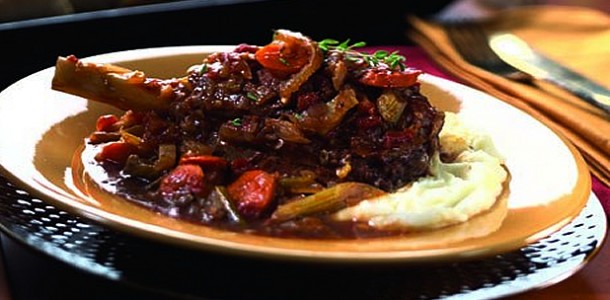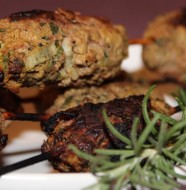- 4 lamb shanks (hind-shanks about 1 1/4 pounds each)
- All-purpose flour
- Extra Virgin Olive Oil
- 1 medium onion diced
- 3 carrots diced
- 3 ribs celery diced
- 3 parsnips diced
- 5 red radishes diced
- 4 cloves garlic
- 2 cups red table wine
- 2 tablespoons finely chopped parsley
- 1 tablespoon finely chopped rosemary
- 1 teaspoon finely chopped fresh thyme
- 1 bay leaf
- 4 cups chicken stock
- Kosher salt and freshly ground black pepper
Braised lamb shank is one of those special dishes that is as impressive as it is delicious. Each plate crowned with an individual shank arrives to the table, fork-tender lamb literally falling off the bone into a dark, rich and savory sauce that fills your kitchen and your home with the most amazing smell. It is a meal that your guests will talk about for some time to come, never knowing the ease with which you pulled it off.
Braising is one of my favorite methods for cooking the cuts of meat that used to be called peasant cuts; the cuts left over after the premium cuts went to market. The fork-tender result is accomplished by browning pieces in oil then slowing cooking them in a vegetable-rich, wine-laced braising liquid. Once in the oven, braising requires very little attention allowing you to focus on the rest of the meal or the rest of your day.
The key here is the type of pot in which you need to braise – a heavy pot with a tight-fitting lid. I use an enameled, cast-iron, 8 quart Dutch Oven for several reasons. With cast iron, heat is evenly distributed and held, making it ideal for sauces, browning, deep frying, searing, baking and braising. The versatility of the cast-iron pot or skillet is unrivaled; use it on the stove-top, grill, or in the oven. If you’re still not convinced, check the price. A cast-iron skillet will cost under $10, a fraction of the price of a comparable heavy aluminum or stainless steel pan, and it should last a lifetime. However, cast iron can become rusty if not properly cared for and seasoned regularly, a big challenge for many people.
Enter the enameled cast iron pot. Once available only to those wishing to spend hundreds of dollars on each piece of cookware, an enameled, cast-iron, 8 quart Dutch Oven can now be had for under $75 at your local mega-mart (an un-enameled cast iron version for about $50). These beautiful pieces of cookware give you all of the benefits of cast-iron without any of the worries attending the proper care and seasoning of traditional cast-iron cookware. They are an absolute joy to cook with and of all of the things that I might suggest to make your time in the kitchen that much more enjoyable, this one tops the list.
For the lamb shanks, what you are looking for are hind-shanks that are about a pound to 1 1/4 pounds each. There are some great ways to use fore-shanks, but they have quite a bit of connective tissue and not enough meat on them to serve as a single portion. Most Whole Foods type stores have hind-shanks in the butcher case. If not, simply ask your butcher. Butchers are a great resource and usually happy to get you what you need.
Directions:
- Generously coat the bottom of your pot with olive oil and bring to a high heat. I like to throw a couple popcorn kernels in the pot to let me know when it reaches 350 degrees. Popcorn pops at exactly 350 degrees, the perfect temperature for browning.
- While the pot is heating, generously salt and pepper your lamb shanks and very lightly dust with all-purpose flour. Add them to the pot once it reaches temperature and brown really well on all sides. Do not rush this step. Take your time and make sure all the surfaces are browned.
- Once browned, remove the shanks and set aside. Add the onion, carrots, celery, parsnips, radish and garlic to the pot stirring frequently until very brown and aromatic, adding more oil as needed. Do not rush this step either. Much of the rich flavor and color of the final dish is developed in this step. I like adding some salt at the start of this step. It will take a bit longer to achieve browning because of the extra water the salt draws out of the vegetables, but ultimately, your final sauce will have a much better flavor and your vegetables will brown more evenly if you add the salt at the beginning of the cooking process.
- Add the parsley, rosemary, thyme and bay leaf and cook for an additional 4 minutes.
- Return the shanks to the pot and pour in the wine and chicken stock. The shanks should be completely submerged so add as much additional water or chicken stock as needed.
- Bring to a simmer on on top of the stove then cover and place in a 350 degree oven for 2 1/2 to three hours. The shanks are done when the meat is fork-tender and and literally falls away from the bone.
- Remove the lamb shanks to a side-dish and cover with foil to keep warm. Strain the vegetables out of the braising liquid and set them aside. Remove as much fat from the surface of the braising liquid as you can.
- Set the braising liquid over a high heat and reduce by half or more. I like a thicker sauce so let mine go a bit further.
- Taste for seasoning, stir in the butter and add the vegetables back to your final braising sauce.
- Serve shanks individually on top of risotto, polenta or by themselves, spooning the rich braising sauce and vegetables on top of each shank.






